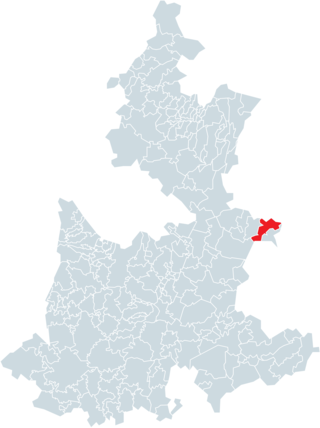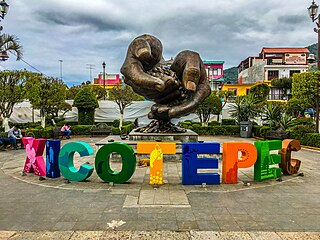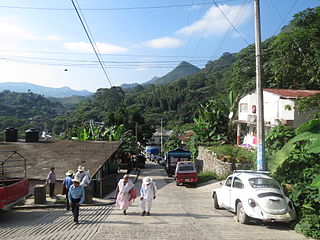Related Research Articles

Tuxpan is both a municipality and city located in the Mexican state of Veracruz. The population of the city was 89,557 and of the municipality was 154,600 inhabitants, according to the INEGI census of 2020, residing in a total area of 1,051.89 km2 (406.14 sq mi). The municipality includes many smaller outlying communities, the largest of which are Alto Lucero and Santiago de la Peña. A local beachside community is also nearby.

Nuevo Casas Grandes is a city and the seat of the Nuevo Casas Grandes Municipality in northern Mexico. It is located in the northwestern part of the state of Chihuahua, on the Casas Grandes or San Miguel river, situated in a wide, fertile valley on the 4,000-foot Mesa del Norte of the Plateau of Mexico. Nearby is the Sierra Madre Occidental.
Tepehuanes is a municipality in the Mexican state of Durango. It is located in the North West of Durango at 25°12'"-26°25'"N 105°23'"-106°40'"W, at an elevation of about 1,830 meters (6000 feet).
Santiago Papasquiaro is a city located in a valley situated on the eastern slopes of the Sierra Madre Occidental in the Mexican state of Durango. As of 2010, the city of Santiago Papasquiaro had a population of 26,121, while the municipality has a census population of 48,482 as of 2015. It is the fourth largest community in the state in terms of population, and is the municipal seat of the municipality of the same name. The municipality has an area of 7,238.4 km2 (2,794.8 sq mi).
Sierra Puebla Nahuatl is one of the Eastern Peripheral varieties of Nahuatl, spoken by ethnic Nahua people in northwestern Puebla state in Mexico.

The Sierra Norte de Puebla is a rugged mountainous region accounting for the northern third of the state of Puebla, Mexico. It is at the intersection of the Trans-Mexican Volcanic Belt and the Sierra Madre Oriental, between the Mexican Plateau and the Gulf of Mexico coast. From the Mesoamerican period to the 19th century, this area was part of a larger region called Totonacapan, and area dominated by the Totonac people, extending further east to the Gulf of Mexico. Political maneuvers to weaken the Totonacs led to the region being divided between the modern states of Puebla and Veracruz with the Puebla section given its current name. Until the 19th century, the area was almost exclusively indigenous, with the four main groups still found here today, Totonacs, Nahuas, Otomis and Tepehuas, but coffee cultivation brought in mestizos and some European immigrants who took over political and economic power. While highly marginalized socioeconomically, the area has been developed heavily since the mid 20th century, especially with the building of roadways linking it to the Mexico City area and the Gulf coast.

Terrenate is a city, and the surrounding municipality of the same name, in the Mexican state of Tlaxcala. It is situated in the highest part of the state, at 2,680 metres above sea level. "Terrenate" is a Nahuatl name meaning "land the colour of masa".
Tenabo is a city in the Mexican state of Campeche. It is located in the north of the state, 35 km from the state capital Campeche, Camp., and 110 km from Mérida, Yucatán, along Federal Highway 180. It serves as the municipal seat for the municipality of the same name.

Acatzingo Municipality is a municipality in the Mexican state of Puebla in south-eastern Mexico.

Pahuatlán, officially Pahuatlán del Valle, is a town and municipality located in the northwest of the state of Puebla in central Mexico. The municipality is part of the Sierra Norte region of the state, a steep mountainous area which receive significant moisture from the Gulf of Mexico, and borders the states of Hidalgo and Veracruz.

Quimixtlán Municipality is a municipality in the Mexican state of Puebla in south-eastern Mexico.

Zacatlán Municipality is a municipality in the Mexican state of Puebla in south-eastern Mexico. Its administrative centre is the city of Zacatlán.

Xicotepec is one of the 217 municipalities that make up the Mexican state of Puebla in central-eastern Mexico. It is located within the Sierra Norte de Puebla and belongs to the first region of the state. Its head is the city of Xicotepec de Juárez, which has been recognized by the Mexico's Secretary of Tourism as one of the 121 pueblos mágicos in the country since 2012.
Zongozotla Municipality is a municipality in the Mexican state of Puebla in south-eastern Mexico.

General Zaragoza is a municipality and town of the northeastern Mexican state of Nuevo León. It is located in the south-eastern part of the state. The town is at 23°58′25″N99°46′23″W. The municipality has a total area of 508 square miles (1,315 km2) and had a population of 5,942 in 2010. Most of the population lives in the town of Zaragoza. The elevation of Zaragoza is 4,520 feet (1,379 m). Zaragoza is bordered by Aramberri, on the south and east by Hidalgo, Tamaulipas, and on the west by Doctor Arroyo.

Huehuetla is a rural municipality in Puebla, Mexico.

Jilotepec is a municipality in the Mexican state of Veracruz, located 11 kilometres (6.8 mi) north-northwest of the state capital Xalapa.

Citlaltépetl is a municipality in the Mexican state of Veracruz, located 223 kilometres (139 mi) northwest of the state capital of Xalapa and 99 kilometres (62 mi) south of the city of Tampico, Tamaulipas.

Zacualpan is a municipality in the Mexican state of Veracruz, located 179 kilometres (111 mi) northwest of the state capital of Xalapa and 56 kilometres (35 mi) northeast of the city of Pachuca, Hidalgo.

The geography of the State of Hidalgo refers to the physical geography and human geography of Hidalgo, a state in central Mexico.
References
- ↑ XII Censo General de Población y Vivienda 2000. Principales resultados por localidad. Puebla , Instituto Nacional de Estadística Geografía e Informática, 2000.
- ↑ "Estado de Puebla-Estacion: Zacapoaxtla (SMN)". Normales Climatologicas 1951–2010 (in Spanish). Servicio Meteorologico Nacional. Retrieved 27 April 2015.
- ↑ "Extreme Temperatures and Precipitation for Zacapoaxtla (SMN) 1944–2009" (in Spanish). Servicio Meteorológico Nacional. Retrieved 27 April 2015.
- ↑ https://www.dimensionantropologica.inah.gob.mx/?p=621 [ bare URL ]